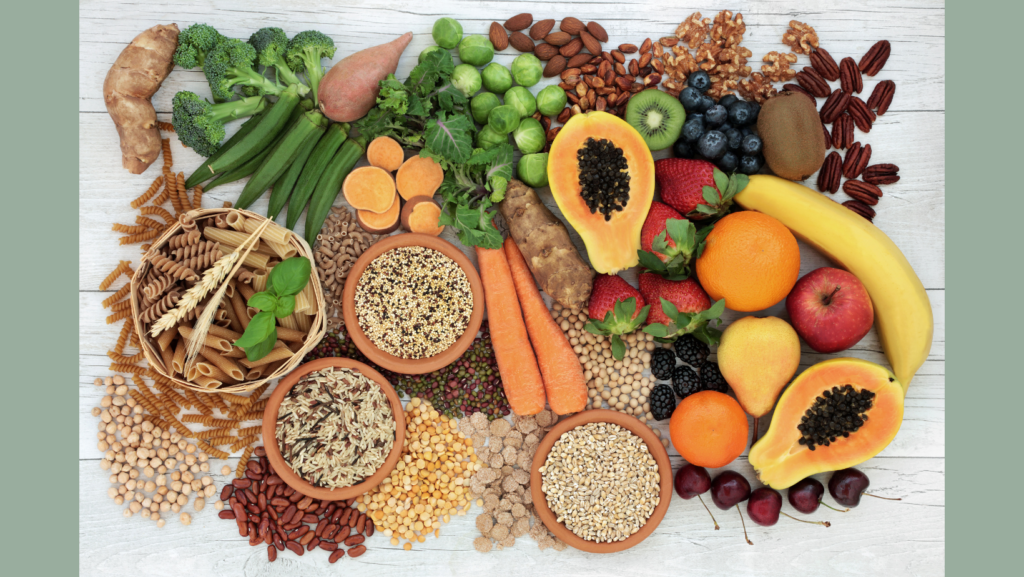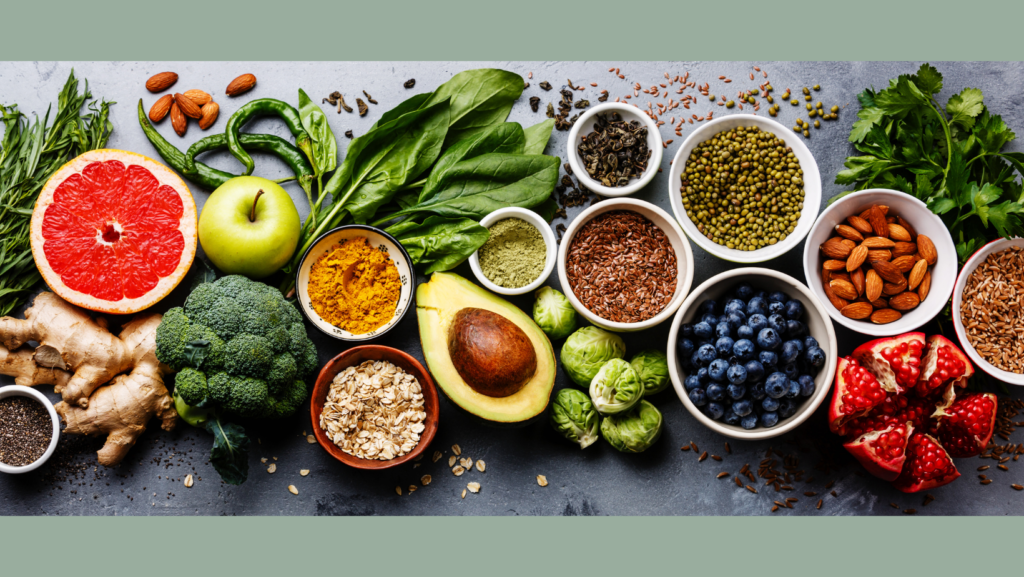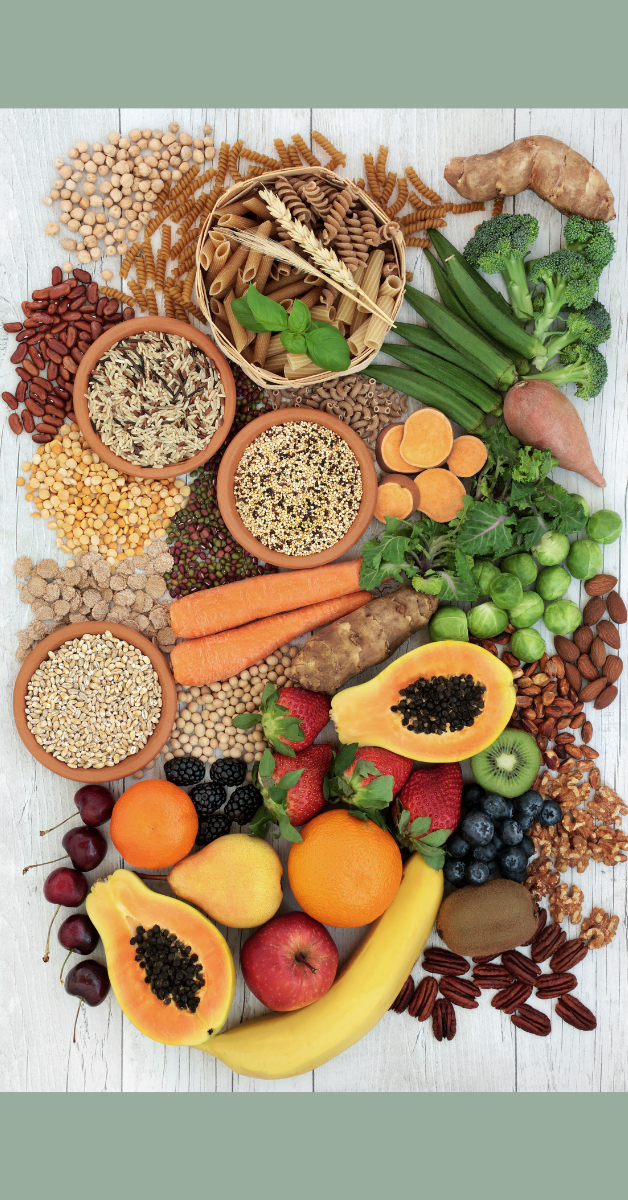What is Fiber:
Fiber is a non-digestible carbohydrate. Unlike other carbohydrates (such as starches and sugars), fiber is not broken down/digested/absorbed in the upper GI tract (small intestine). We humans lack the enzymes to digest fiber, but the microbes living in our colon do! So when fiber reaches the colon (large intestine) it feeds many of our gut microbes which is a good thing! Our gut microbes digest fibers and produce short chain fatty acids (SCFAs), whose beneficial effects on health are well documented. (1)
There are two main types of fiber, dietary and functional (2):
- Dietary fiber: Is non-digestible carbohydrate found in plant foods. Fruits, vegetables, whole grains, nuts, seeds, beans, lentils, peas.
- Dietary fiber is a diverse group of compounds and there are various fibers in plant foods, like: Cellulose, Hemicelluloses, lignins, β- Glucans, galactomannans, pectins, inulin, Galactooligosaccharides, dextrins
- Functional Fiber: is isolated, nondigestible carbohydrate that has been shown to have beneficial physiological effects on humans.
- Fiber supplements fall under this category. It should be noted fiber supplements confer some but not all health benefits found in dietary fibers.

Dietary Fiber for Health:
A growing body of evidence shows that adequate fiber intake benefits digestion and reduces risk of chronic disease. A diet rich in fiber has been associated with overall health and wellbeing. Specifically, high-fiber dietary patterns are associated with lower risk for diabetes, heart disease and several types of cancer: breast, ovary, endometrial, and gastrointestinal cancer – especially colon cancer.
One thing to consider is that in addition to fiber, these plant foods contain other beneficial nutrients including vitamins, minerals, phytochemicals. Fiber + these other nutrients work together to support good health.
Fiber Goals:
Fiber goals: The Institute of Medicine recommends 25 grams of fiber for women and 38 grams for men under 50 years of age. For those over age of 50 the daily recommended fiber intake is slightly lower at 21 grams for women and 30 grams for men.(3)
Tolerance: In general fiber tolerance is individualized but this is especially true for those with a digestive condition like irritable bowel syndrome (IBS), gastroparesis, and inflammatory bowel disease (IBD). There are various strategies and techniques that can be taken to improve tolerance of plant foods for those with digestive conditions. Fiber tolerance and intolerance can be influenced by portion sizes/quantity, raw vs cooked, as well as a fiber’s characteristics and particle size.
Variety: In addition to eating enough fiber, aim to eat a variety of plant foods to meet fiber and nutrient needs. Remember, plant-foods contain a mixture of different types of fiber as well as different vitamins, minerals, and phytochemicals. One study by the American Gut Project found that people who ate more than 30 different plant foods each week had a more diverse gut microbiome compared with those who ate 10 or less. (4) Higher diversity in the gut microbiome is seen as a positive thing, as greater diversity has been generally associated with health. Whereas lower diversity has been observed in a variety of disease states. (5)
Tips for increasing fiber: No need to rush and add in all the high fiber foods you can get your hands on in one day. Instead, gradually add in fiber-containing foods overtime and allow the body to adjust. Increase fiber intake as tolerated and make sure you stay hydrated. Increasing fiber intake too quickly and/or increasing fiber intake while being dehydrated generally doesn’t make us feel great and could lead to increased GI symptoms.
Fiber Characterists:
Did you know that different fibers can exert different health benefits?! For example, certain types of fiber can improve cholesterol and laxation. Why is that? Well, it depends on a fiber’s characteristics. Different fibers have different properties or characteristics. And these properties determine its clinical effectiveness, they determine how the fiber is going to behave in the GI tract. (6)
The 3 characteristics are:
- Solubility
- Fermentability
- Viscosity
Let’s take a deeper look at what each of these means:
Solubility: Definition: capable of being dissolved in fluid
- Soluble – Absorbs water, Bulks stool, Slows fecal transit time
- Insoluble – Does not absorb water, Moves waste quickly through the large intestine (dependent on particle size)
Fermentability: Definition: the chemical breakdown of a substance by bacteria, yeasts, or other microorganisms, typically involving effervescence and giving off heat. Our gut microbes possess a variety
of enzymes (glycohydrolases) which enables the digestion of certain dietary fibers. (7)
- Highly Fermentable Fibers: Fructans (garlic, onion), galacto-oligosaccharides (green peas, beans, soy); Wheat dextrin, inulin, polydextrose, guar gum
- Low Fermentable Fibers: Lignan/flaxseed, oats, psyllium, Cellulose, sterculia (karaya gum), methylcellulose
Viscosity: Definition: the state of being thick, sticky and semifluid in consistency; resist flow (magnitude of internal friction)
- High Viscosity: Ability to thicken when hydrated, occurs in a concentration-dependent manner. A subset of viscous fibers have a gel-forming capability
- Beta glucans, psyllium, guar gum
- Low Viscosity: Does not thicken with hydration, no gel-forming capabilities
- Wheat dextrin / bran, polydextrose, inulin
Final Thoughts on Dietary Fiber:
In summary, fiber intake is essential for health and it is found in plant foods. Choosing a variety of plant foods that you tolerate will help you meet your nutrient needs and support your overall and gut health.
Last but certainly not least: fiber containing foods are DELICIOUS. I know “eat your fruits and vegetables” isn’t sexy nutrition advice. But there are endless ways to enjoy plant foods in our meals and snacks. If you are looking for inspiration, check out my new website, Plant Empowered Kitchen for delicious recipes that are simple, satisfying, and packed with fiber.
Want to learn more about dietary fiber, especially for those with digestive disorders? My colleague and friend Kate Scarlata talk all about fiber on her Digestive Health IG Live Series

References:
1) Tan J, McKenzie C, Potamitis M, Thorburn AN, Mackay CR, Macia L. The role of short-chain fatty acids in health and disease. Adv Immunol. 2014;121:91-119. doi:10.1016/B978-0-12-800100-4.00003-9
2) Institute of Medicine (US) Panel on the Definition of Dietary Fiber and the Standing Committee on the
Scientific Evaluation of Dietary Reference Intakes. IV. Proposed definition of dietary fiber. In: Dietary
Reference Intakes Proposed Definition of Dietary Fiber. Washington, DC: National Academies Press (US); 2001. https://www.ncbi.nlm.nih.gov/books/NBK223591/.
3) Institute of Medicine. Dietary Reference Intakes for Energy, Carbohydrate, Fiber, Fat, Fatty Acids, Cholesterol, Protein, and Amino Acids. Washington, DC: The National Academies Press; 2005.
https://doi.org/10.17226/10490.
4) McDonald D, Hyde E, Debelius JW, et al. American Gut: an Open Platform for Citizen Science Microbiome Research. mSystems. 2018;3(3):e00031-18. Published 2018 May 15. doi:10.1128/mSystems.00031-18
5) Lloyd-Price, J., Abu-Ali, G. & Huttenhower, C. The healthy human microbiome. Genome Med 8, 51 (2016). https://doi.org/10.1186/s13073-016-0307-y
6) McRorie JW Jr, McKeown NM. Understanding the Physics of Functional Fibers in the Gastrointestinal Tract: An Evidence-Based Approach to Resolving Enduring Misconceptions about Insoluble and Soluble Fiber. J Acad Nutr Diet. 2017;117(2):251-264. doi:10.1016/j.jand.2016.09.021
7) Atzler JJ, Sahin AW, Gallagher E, Zannini E, Arendt EK. Characteristics and properties of fibres suitable for a low FODMAP diet- an overview. Trends in Food Science & Technology. 2021;112:823-836.

